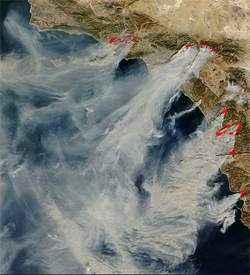Despite fire risk, more Americans building near forests
Despite fire risk, more Americans building near forests
mongabay.com
October 29, 2007
While much of the world is seeing an urbanization trend, U.S. housing density around national forests is expected to rise by 2050, reports a study from the U.S. Forest Service. The shift could put more people at risk of devastating forest fires and increase pressure on forests and the services they provide.
“Forests, farms, ranches, and other open spaces are rapidly being developed as more people are choosing to live at the urban fringe and in scenic, rural areas,” said Forest Service Chief Abigail Kimbell. “This development is affecting our ability to manage national forests and grasslands as well as our ability to help private landowners and communities manage their land for public benefits and ecosystem services.”
The study, titled “National Forests on the Edge: Development Pressures on America’s National Forests and Grasslands”, found that nine national forests and grasslands are “projected to experience substantial increases in housing density on at least 25 percent of adjacent private land.”
 Several massive wildfires were raging across southern California over the weekend of October 25, 2003. Whipped by the hot, dry Santa Ana winds that blow toward the coast from interior deserts, at least one fire grew 10,000 acres in just 6 hours. The Moderate Resolution Imaging Spectroradiometer (MODIS) on the Terra satellite captured this image of the fires and clouds of smoke spread over the region on October 26, 2003. |
“Almost all eastern national forests are may experience high to moderate increases in adjacent housing density,” said the Forest Service in a statement. “Private lands bordering national forests in Colorado, northwestern Montana, northern Idaho, California, and Oregon are also projected to experience moderate to high increases. Thirteen national forests are projected to experience substantial residential development on more than 1/2 million acres of adjacent, currently rural, private lands. Most of these national forests are located in southern states and in the Northeast and Great Lakes regions.”
The report comes as California firefighters work to extinguish the last bush fires still burning in the state. In total, the fires consumed some 450 square miles and forced the evacuation of nearly a million residents. More than 1600 homes were destroyed and damaged are expected to exceed one billion dollars for lost homes alone.
With more Americans building homes in fire-prone areas and evidence that the incidence of large forest fires is increasing due to climate change-induced drying, there are concerns that the recent fires in California could become a more regular occurrence. According to The Economist, some insurers have already stopped issuing insurance policies to new homeowners living in at-risk areas.
National Forests on the Edge